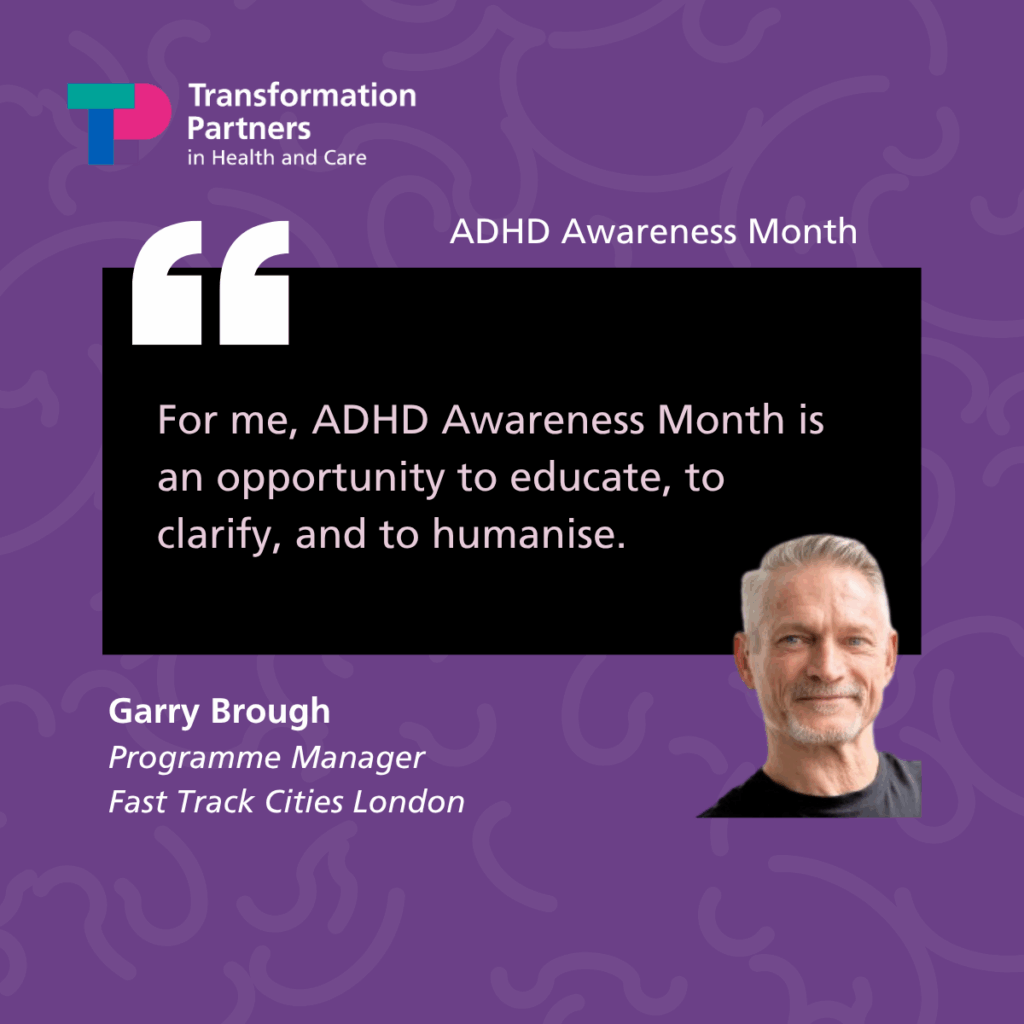October is ADHD Awareness Month, and this year’s theme “The Many Faces of ADHD” reminds us that there’s no single story or experience that defines neurodiversity.
At Transformation Partners in Health and Care (TPHC), we’re marking the month by sharing real experiences from our colleagues and shining a light on the diverse ways ADHD can show up, and how we can create workplaces that are truly neuroinclusive.
We spoke to Programme Manager, trainer, public speaker, advocate and activist Garry Brough, who shared his deeply personal journey to diagnosis, and how it reshaped not only his understanding of himself, but his approach to life and work.

“For the first time in my life, I had peace.”
Garry first suspected he might have ADHD when he was working in senior management in an HIV charity. He was juggling multiple roles — project delivery, finance, even an office move — and found his ability to cope slipping away.
An online test led to a referral through his GP and, eventually, a diagnosis via Psychiatry UK. Starting on medication was, in his words, “nothing short of miraculous — for the first time in my life I had peace. I hadn’t realised how noisy my head had been.”
But medication wasn’t a one-size-fits-all solution. “At first I felt more focused, but less emotionally connected,” he says. “We found a balance over time — enough to calm my mind without losing the emotional engagement that’s part of who I am.”
Reframing the past
The diagnosis brought clarity but also reflection. “In my teens, before I knew I had ADHD, I used alcohol to quiet my mind, but that brought its own problems” Garry shares. Having lived with HIV since his twenties and been in recovery from drugs and alcohol for decades, he recognises how often ADHD and substance use overlap — especially in the HIV sector, where neurodivergence can be more common than people realise.
“In one organisation I worked with, around a third of staff identified as neurodivergent. There’s definitely a link between ADHD, self-medication and the coping strategies people develop over time. Understanding that helps us create more compassionate workplaces.”
Tools, support and inclusion
Garry now uses a combination of strategies: meditating daily for over 30 years, cognitive approaches like CBT, a herbal tincture that helps his focus and ADHD medication on days where complex multitasking may be needed. He also received coaching through Access to Work and uses a mind-mapping tool to structure ideas visually rather than linearly and this is something that better suits how his brain works.
Yet even with a diagnosis, getting practical support wasn’t easy. “It took six months for my employer to install the tool that had been recommended. The process shouldn’t depend on persistence. Adjustments should be proactive and straightforward.”
His message to organisations is clear; make adjustments accessible, normal and fast. The aim isn’t to “fix” anyone but is to help people work in ways that bring out their best.
Redefining what ADHD means
Garry’s story challenges common misconceptions about ADHD. “People often assume it means you can’t function or that you’re unreliable. That’s not true. ADHD doesn’t define capability, it defines difference.”
He believes we need to move beyond deficit-based thinking and celebrate what neurodivergent people bring: creativity, empathy, adaptability, and a fresh perspective.
“Awareness months like this help us humanise difference and build empathy,” he says. “If we can accept and understand diverse ways of thinking, workplaces and people will thrive.”
At TPHC, we’re proud to champion the many faces of ADHD and to learn from colleagues like Garry, whose honesty helps us all see neurodiversity in a new light.
